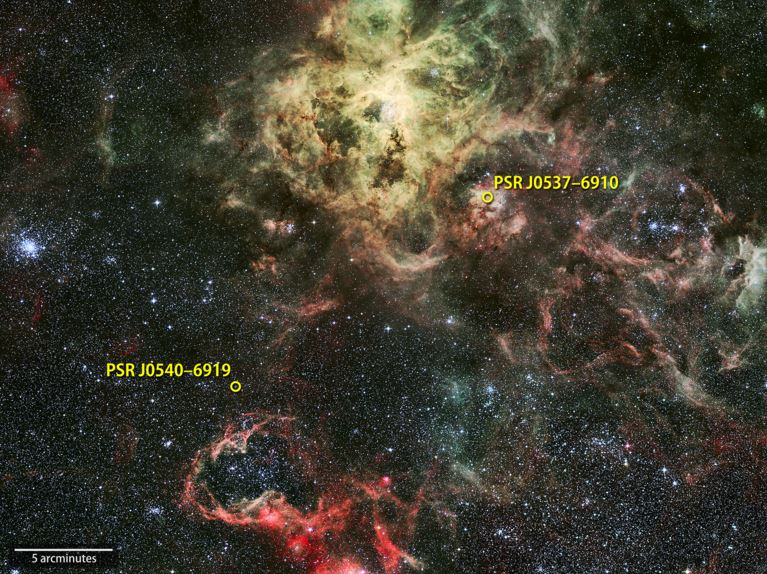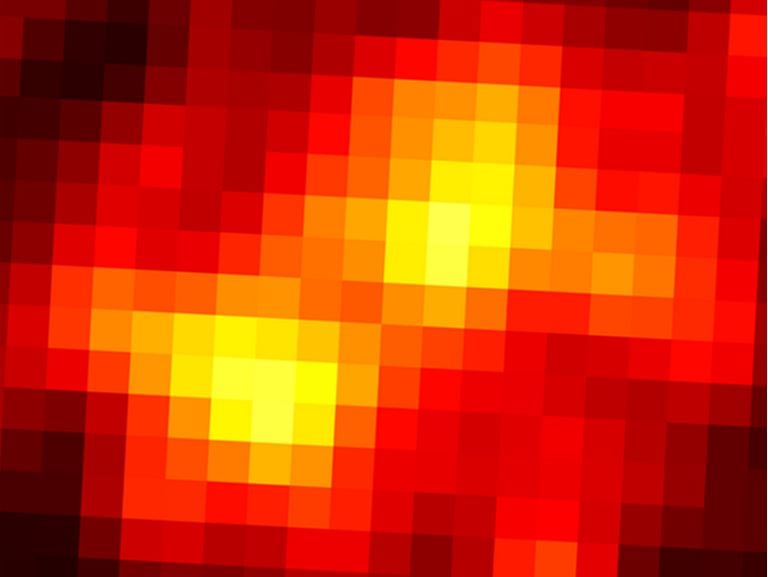Scientists have discovered the most luminous gamma-ray pulsar known. It is also the first gamma-ray pulsar to be found in a galaxy other than our Milky Way, said scientists at NASA’s Goddard Space Flight Center.
A gamma-ray pulsar is a spinning neutron star that emits gamma-ray photons. A neutron star is an ultra-compact star with a radius of about 10 km and a mass of approximately 1.5 times that of our Sun.
The researchers have published their findings in the academic journal Science.
This pulsar lies in the outer parts of the Tarantula Nebula in the Large Magellanic Cloud, a small galaxy, about 163,000 light-years from Earth, that orbits our Milky Way.
 PSR J0540-6919 now holds the record as the highest-luminosity gamma-ray pulsar. In the background you can see the Tarantura Nebula and its surroundings in visible light. (Credit: NASA’s Goddard Space Flight Center)
PSR J0540-6919 now holds the record as the highest-luminosity gamma-ray pulsar. In the background you can see the Tarantura Nebula and its surroundings in visible light. (Credit: NASA’s Goddard Space Flight Center)
The pulsar, known as PSR J0540-6919, was detected as a bright source of gamma rays (electromagnetic radiation of an extremely high frequency consisting of high-energy photons) – the highest-energy form of light – early in the Fermi mission.
Researchers first thought it was the result of a supernova
At first, astronomers thought the glow was due to collisions of subatomic particles accelerated in the shock waves produced by supernova explosions. A supernova is a star that suddenly becomes ultra-bright because of a catastrophic explosion that ejects most of its mass.
Research leader, Pierrick Martin, an astrophysicist who works at the National Center for Scientific Research (CNRS) and the Research Institute in Astrophysics and Planetology in Toulouse, France, said:
“It’s now clear that a single pulsar, PSR J0540-6919, is responsible for roughly half of the gamma-ray brightness we originally thought came from the nebula. That is a genuine surprise.”
When a gigantic star explodes as a supernova, its core may survive as a neutron star, where the mass of 500,000 Earths is squashed into a magnetized ball about the size of Washington D.C.
 A gamma-ray view of the same region shown in the image above in visible wavelengths. The lighter colors represent a greater number of gamma rays, with energies from 2 to 200 billion electron volts. The two pulsars clearly stand out. (Credits: NASA/DOE/Fermi LAT Collaboration)
A gamma-ray view of the same region shown in the image above in visible wavelengths. The lighter colors represent a greater number of gamma rays, with energies from 2 to 200 billion electron volts. The two pulsars clearly stand out. (Credits: NASA/DOE/Fermi LAT Collaboration)
A young isolated neutron star rotates completely about 10 times per second. Its rapidly-rotating magnetic field powers beams of radio waves, X-rays, visible light, and gamma rays.
If the beams reach Earth, scientists observe a regular pulse emission, and the phenomenon is classified as a pulsar.
Tarantula Nebula has two pulsars we know of
We know of two pulsars in the Tarantula Nebula – PSR J0540-6919 and PSR J0537-6910, which are also known by their respective short forms J0540 and J0537. They were discovered with the help of NASA’s Einstein and Rossi X-ray Timing Explorer satellites, respectively.
J0537 spins at nearly 62 times per second (the fastest rotation we know of for a young pulsar), and J0540 at just under 20 times per second.
Even so, it took over six years’ worth of observations by Fermi’s LAT (Large Area Telescope), as well as a complete reanalysis of LAT’s entire data in a process called Pass 8, to detect J0540’s gamma-ray pulsations.
While the Fermi data has established upper limits for J0537’s gamma-ray pulses, they have not been detected yet.
Co-author Lucas Guillemot, who works at the Laboratory for Physics and Chemistry of Environment and Space, operated by CNRS, and the University of Orléans in France, said:
“The gamma-ray pulses from J0540 have 20 times the intensity of the previous record-holder, the pulsar in the famous Crab Nebula, yet they have roughly similar levels of radio, optical and X-ray emission. Accounting for these differences will guide us to a better understanding of the extreme physics at work in young pulsars.”
J0540 is very young
J0540 is about 1,700 years old, and is considered a rare find, the scientists said. It is about twice the age of the Crab Nebula pulsar. Most of the 2,500+ known pulsars, on the other hand, are between 10,000 to hundreds of million years old.
Despite the luminosity of J0540, not enough gamma rays reach the LAT to detect pulsations without knowing the period in advance.
This information comes from extensive and long-term X-ray monitoring using RXTE, which recorded both pulsars from the beginning of the Fermi mission to the end of 2011, when RXTE operations shut down.
Co-author Francis Marshall, an astrophysicist at NASA’s Goddard Space Flight Center in Maryland, said:
“This campaign began as a search for a pulsar created by SN 1987A, the closest supernova seen since the invention of the telescope. That search failed, but it discovered J0537.”
Before Fermi was launched in 2008, we knew of just seven gamma-ray pulsars. So far, the mission has discovered over 160.
NASA’s Fermi Gamma-ray Space Telescope is a particle physics and astrophysics partnership, developed in collaboration with the US Department of Energy, plus important contributions from academic centers and partners in the US, Sweden, Japan, Germany, Italy and France.
NASA Goddard Video – 1st Gamma-ray Pulsar in Another Galaxy
This NASA video talks about the discovery of the first gamma-ray pulsar outside our galaxy. The object sets a new record for the most luminous gamma-ray puslar known to scientists.

